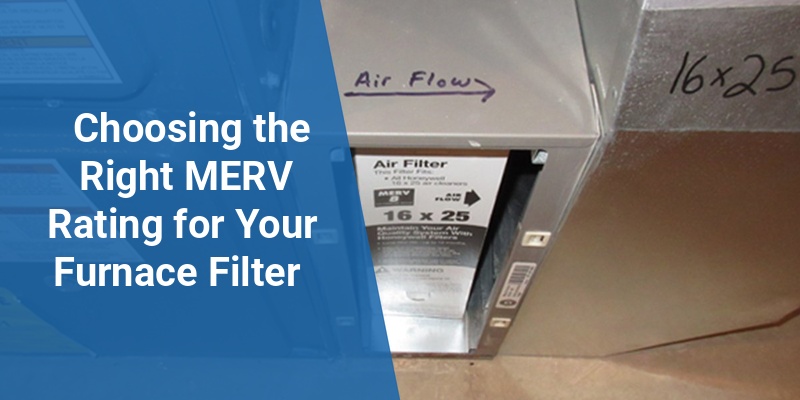Selecting the correct MERV (Minimum Efficiency Reporting Value) rating for your furnace filter is essential for maintaining indoor air quality and protecting your HVAC system. The ideal MERV rating balances effective filtration with proper airflow, ensuring your furnace operates efficiently while keeping allergens, dust, and contaminants at bay. This guide provides detailed insights into what MERV rating suits common household needs, offering a clear framework for choosing the best filter for your furnace.
| MERV Rating | Filtration Efficiency | Best Use Case | Impact on Airflow |
|---|---|---|---|
| 1-4 | Basic dust and lint filtering | Minimal filtration, large particles | Minimal airflow restriction |
| 5-8 | Adequate for mold spores, dust mites | Standard residential use | Low airflow restriction |
| 9-12 | Improved filtration of pet dander, fine dust | Homes with allergies or pets | Moderate airflow restriction |
| 13-16 | High-efficiency filtration for bacteria, smoke | Medical facilities, households with severe allergies | Higher airflow restriction |
What Is MERV and Why Does It Matter?
MERV stands for Minimum Efficiency Reporting Value and measures how effectively an air filter captures particles from the air. The rating ranges from 1 to 16, with higher values indicating finer filtration capabilities. For furnace filters, understanding the MERV rating is critical because it affects both the quality of air inside your home and the performance of your heating system. Filters with too low a MERV may let harmful particles circulate, while filters with too high a MERV can restrict airflow and strain your furnace.
Factors to Consider When Choosing a MERV Rating
Several factors should be evaluated when deciding the appropriate MERV rating for your furnace filter:
- Indoor Air Quality Needs: Allergy sufferers or homes with pets often require higher MERV ratings.
- Furnace Compatibility: Your HVAC system’s design and blower capacity limit the maximum MERV rating it can handle without airflow issues.
- Maintenance and Cost: Higher MERV filters tend to cost more and may need more frequent replacement.
- Energy Efficiency: Restrictive filters can force your system to work harder, increasing energy consumption.
MERV Ratings Explained for Residential Furnaces
MERV 1-4: Basic Filtration
Filters in this range trap large particles like dust and lint. They are low cost and cause minimal airflow resistance. However, they are less effective at capturing smaller airborne contaminants such as pollen, mold spores, and pet dander. These are typically used in older furnace systems or as pre-filters.
MERV 5-8: Standard Residential Filters
This range is the most common for household furnaces. It captures particles such as mold spores, dust mite debris, and pet dander. These filters balance filtration and airflow well, making them suitable for most homes without specialized air quality needs.
MERV 9-12: Enhanced Filtration for Allergy Control
Filters rated 9-12 excel at removing smaller particles including vehicle exhaust, hair spray, and some bacteria. Homes with allergy or asthma concerns benefit greatly from this range. Though these filters may slightly reduce airflow, most modern furnaces can handle this rating without efficiency loss.
MERV 13-16: High-Efficiency Filters
These filters capture fine particles like smoke, bacteria, and virus carriers. They are often used in medical environments or homes with severe allergy sufferers. Using such filters in residential furnaces requires checking manufacturer recommendations as they can significantly restrict airflow and impact furnace operation if not supported.
Call 888-906-9139 for Free Local HVAC Quotes – No Obligation, Just Savings!
How to Check Furnace Compatibility with High MERV Filters
Before upgrading to a filter with a higher MERV rating, review the furnace’s user manual or consult an HVAC professional. Many modern furnaces are designed to handle filters up to MERV 12 without issue. However, for ratings above that, system modifications or blower upgrades may be necessary to maintain proper airflow.
Installing a filter that is too dense can cause your furnace to overheat, reduce heating efficiency, increase wear and tear, and raise utility costs. Regular maintenance and professional inspections help ensure optimal system performance when using higher MERV filters.
Additional Tips for Furnace Filter Maintenance
- Replace filters regularly: Follow manufacturer recommendations, typically every 1 to 3 months for standard use.
- Monitor airflow: Noticeable decrease in airflow or uneven heating can signal a clogged or over-efficient filter.
- Use properly sized filters: Ensure filters fit snugly to prevent air bypassing the filter media.
- Upgrade HVAC system: For persistent airflow issues with high MERV filters, consider a system upgrade.
Benefits of Choosing the Right MERV Filter
- Enhanced indoor air quality: Proper filtration removes pollutants, allergens, and odors effectively.
- Longer furnace lifespan: Protects blower fan and heat exchanger from dust buildup.
- Energy savings: Proper airflow helps furnace operate efficiently and reduces utility bills.
- Health improvements: Cleaner air reduces allergy and asthma symptoms.
Conclusion: Selecting the Ideal MERV Rating for Your Home
Choosing the right MERV rating involves weighing indoor air quality needs against furnace performance capabilities. Most American households benefit from a MERV 5-8 filter for general use, with upgrades to MERV 9-12 for allergy control. Only consider filters rated MERV 13 or higher if your system supports it and you require advanced filtration. Consulting with an HVAC professional helps ensure you select the best solution for your furnace while sustaining clean air and efficient heating throughout your home.
